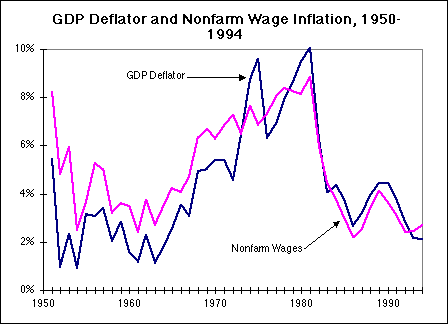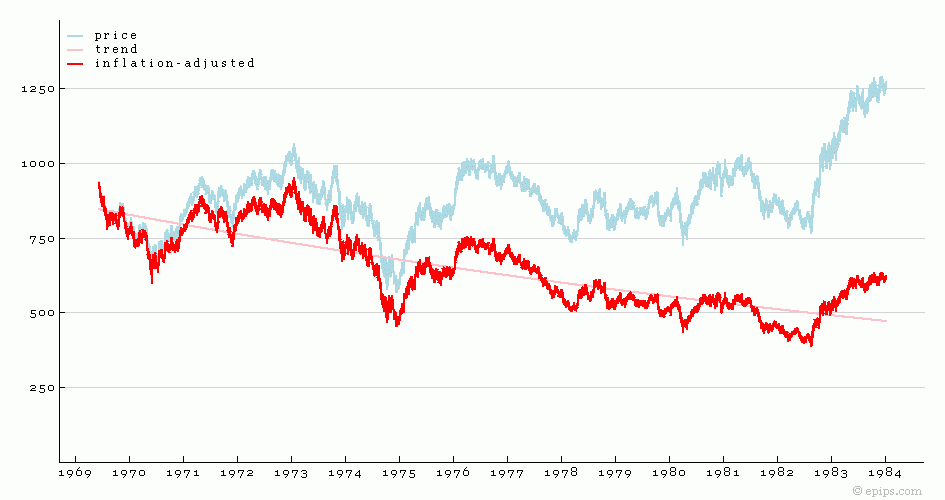| 作者 |
 [原创]老狼在主坛谈通胀,他的地盘嘛。那我在这儿谈通胀(老文章了) [原创]老狼在主坛谈通胀,他的地盘嘛。那我在这儿谈通胀(老文章了) |

 |
theoretical
[博客]
[个人文集]


头衔: 海归上校
声望: 院士
性别: 
加入时间: 2006/10/13
文章: 5521
海归分: 69567
|
|
|
作者:theoretical 在 谈股论金 发贴, 来自【海归网】 http://www.haiguinet.com
文科生的弱点,1。凭直觉,先有论点再翻论据;2。无纪律性,漫山遍野的跑.
1,Inflation has demand pull inflation and cost push inflation. What Xing said was cost push inflation, which arise from the supply side of the economy. Rising per-unit production costs drive up general prices. This squeezes profits, and businesses will produce less but charge more. Output and employment generally decline. Cost-push inflation usually follows a supply shock (an abrupt increase in resource prices). In the 1970's, America experienced this type of inflation following OPEC's decision to drastically raise oil prices.
2. What did happened in US around 1960 to 1970s, especailly wages. Wage inflation increases sharply in the mid- to late-1960s, from around 3 percent per year on average to some seven percent per year. Thereafter it drifts upward, reaching a peak of some nine percent per year by the beginning of the 1980s. The large cycles in price inflation are absent from movements in nominal wages: "special factors" like oil shocks, food price shocks, shortages, and so forth are hard to detect in the pattern of nominal wage movements. (chart 1) Anway, IMHO, currently it is very hard to expect huge wage increase like 1970s. Among G7, only Germany see some siganificant wage raise, but German's economic is another topic. Let's assume we do have wage increase and we do have cost push inflation, then what?
3.By the beginning of 1969, the U.S. had already finished its experiment: was it possible to have unemployment rates of four percent or below without accelerating inflation? The answer was reasonably clear: no. Then, how come we had low unemployment rate and low inflation since 1998 to 2007. Well, we had .com bubble which induced huge amounts investments to keep unemployment rate low, then we had loose credit, which helped strong demand, of course, cheap Chinese labor kept the inflation low. Now, with the commodities price moving up due to EVERTBODY's printing machine, what will happen? Now, let's take look at a classic cost push inflation, US in 70s' (chart 2) You can check inflation rate when market topped or bottomed from this site:
https://www.usinflationcalculator.com/inflation/historical-inflation-rates/
So, it is very clear to me that cost push inflation did not really push the market to big bull market. The super bull market run started in 1982 (bottom) when inflation rate is 6.2 and reach its 1st peak in 1983, while inflation rate was 3.6. After that, we have not seen inflation rate above 5 except 1990, which is a pig's yr at the best. How did this happen? Well, since 1982, US entered debt economy, the inflation was transfered from cost push to demand pull. In general, I believe, cost push inflation won't do any good to stock market either this time, even any inflation can indeed happen. So, what does we need to long and sleep well at night, here is one idea for long term holding, Corn. You can back check corn price during that period.
In general, under the best of the best of the best condition, we may see cost push inflation. However, the real story of price up is the reflection of true paper money value.


作者:theoretical 在 谈股论金 发贴, 来自【海归网】 http://www.haiguinet.com
|
|
|
| 返回顶端 |
|
 |
|
-
 [原创]老狼在主坛谈通胀,他的地盘嘛。那我在这儿谈通胀(老文章了) -- theoretical - (3349 Byte) 2011-3-05 周六, 07:46 (3061 reads) [原创]老狼在主坛谈通胀,他的地盘嘛。那我在这儿谈通胀(老文章了) -- theoretical - (3349 Byte) 2011-3-05 周六, 07:46 (3061 reads)
|
|
|
|
您不能在本论坛发表新主题, 不能回复主题, 不能编辑自己的文章, 不能删除自己的文章, 不能发表投票, 您 不可以 发表活动帖子在本论坛, 不能添加附件可以下载文件, |
|
|
